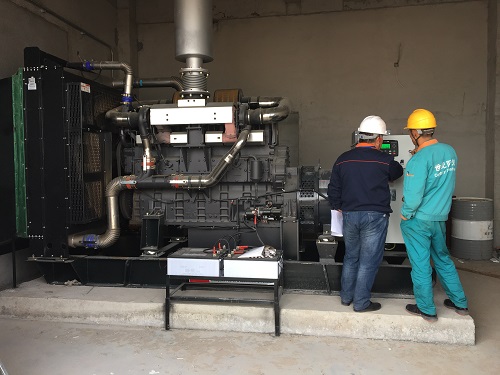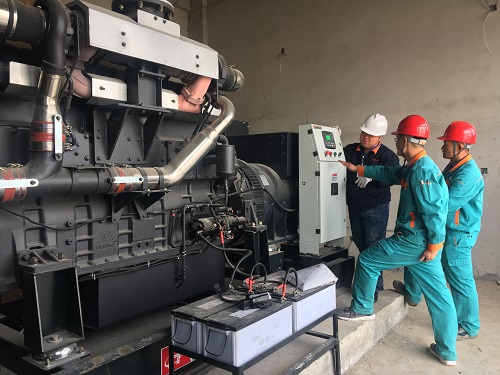Well, the impact of high altitude environments on
diesel generator sets is multifaceted and significant, primarily due to three core factors: low air pressure, low air density, and decreased oxygen content. The following is a detailed analysis:
Core Impact: Lack of Oxygen and Low Pressure
1. Power Decrease and Insufficient Output:
Cause: Reduced air density reduces the amount of oxygen entering the cylinder. Diesel engines rely on pressure for combustion, and their combustion efficiency is directly dependent on the oxygen supply. Lack of oxygen leads to incomplete combustion of the fuel.
As a general rule of thumb, for every 1,000 meters increase in altitude, the output power of a diesel generator set decreases by approximately 8% to 12%. For example, a generator rated at 100 kW at a 3,000-meter altitude might only have an actual sustainable output power of around 70-80 kW. This is the most significant and core impact!
2. Reduced Combustion Efficiency Leads to Increased Fuel Consumption
Cause: Lack of oxygen leads to incomplete combustion, preventing some fuel from being converted into useful energy, resulting in increased soot (black smoke) and unburned hydrocarbons.
Result:
Increased fuel consumption per unit of power (higher than fuel consumption). Temperature increases (combustion delay). Emissions deteriorate (visible increases in black smoke, carbon dioxide, carbon monoxide, and other substances).
3. Starting difficulties:
Cause:
Lack of oxygen: Low final compression pressure and temperature during starting (lower air density results in a lower compression ratio), hindering fuel autoignition.
Additional low temperatures: Plateau regions are often characterized by low temperatures, especially at night and in winter. Low temperatures themselves increase oil viscosity and starting torque; reduced battery capacity and voltage slow starting speed, further worsening starting conditions. Low pressure also affects the performance of the starter motor.
Result: Long starting times, reduced starting success rates, or even failure to start.
4. Increased exhaust temperature and increased heat load:
Cause:
Combustion lag (lack of oxygen slows combustion and prolongs the combustion process).
To compensate for power loss, operators may artificially increase the throttle (increasing fuel supply), resulting in an excessive air coefficient, worsened combustion, and a sharp increase in exhaust temperature.
Risk: Overheating of components such as the cylinder head, piston, valves, and turbocharger, accelerating wear and premature damage, and even cylinder scuffing and burnout.
5. Changes in the operating conditions of the supercharging system:
Increased turbocharger burden: The supercharger is a key feature of high-altitude diesel engines, partially compensating for insufficient air density by increasing intake pressure. However, at extremely high altitudes (e.g., >3,500 meters), even at full turbocharger load, it may not be able to reach the intake pressure (absolute pressure) found on plains. The turbocharger must operate at a higher speed to achieve a lower boost ratio, which reduces efficiency.
Surge risk: Under the low pressure of high altitudes, the turbocharger compressor operating point may be closer to the surge line, increasing the risk of unstable operation.
Turbine overspeed risk: Overfueling in pursuit of power results in excessive exhaust energy, potentially causing the turbine speed to exceed the design limit and damaging the turbocharger.
6. Reduced cooling system efficiency:
Cause:
Decreased boiling point: Coolant's boiling point drops significantly in low-pressure environments. For example, at an altitude of 3,000 meters, the boiling point is approximately 900°C; at 4,000 meters, it is approximately 87°C; and at 5,000 meters, it is approximately 844°C. The engine is more likely to "boil."
Reduced Cooling Capacity: Low air density reduces the amount of cooling air flowing through the radiator, potentially reducing fan efficiency and resulting in poor cooling.
Result: The engine may overheat even at low to medium loads, exacerbating the problem mentioned in point 4 (increased heat load).
7. Lubrication Issues:
Low-Temperature Starting Wear: Low oil viscosity and poor fluidity at low temperatures result in insufficient lubrication during initial startup, exacerbating wear.
High-Temperature Dilution/Oxidation: High temperatures and potential overheating accelerate oil aging and oxidation, shortening oil change intervals.
Sealing Issues: Low air pressure exacerbates oil vapor evaporation and impacts the crankcase ventilation system.
8. Electrical System Impact:
Low air pressure reduces the dielectric strength of the air, potentially increasing the risk of corona or arcing in electrical equipment (such as generators, switches, and terminals), especially in humid environments.
Low-Temperature Impact: Low temperatures significantly reduce battery capacity (possibly to 50% or less), lowering output voltage and current, and impacting starting performance and control system power supply stability. Cables may become stiff and brittle.
9. Materials and Sealing:
The large temperature swing between day and night causes ultraviolet rays to accelerate the aging and embrittlement of rubber and plastic components, leading to seal failure and pipe leaks.
Components subject to high temperatures and pressure, such as turbochargers and intake and exhaust ducts, are more susceptible to damage under high loads.
How to Cope with the Impact of the Plateau Environment (Selection and Usage Recommendations)
1. Choose a unit designed for plateau operation or perform altitude calibration:
Key: Be sure to clearly inform the supplier of the intended operating altitude when purchasing! Reputable manufacturers will perform altitude calibration on the unit.
Critical Corrective Measures Typically Include:
Increasing turbocharger specifications or implementing secondary turbocharging: This provides a higher boost ratio and increased air flow.
Adjusting the fuel injection system (increasing the injection pump plunger, modifying injection timing): This optimizes combustion in the high altitude environment and matches the air volume. However, be careful to prevent excessive deterioration of combustion and exhaust temperatures.
Increasing the radiator area or using a high-pressure radiator cap: This improves the cooling system's heat dissipation capacity and boiling point.
Adjusting the air-fuel ratio control: This ensures a proper air-fuel ratio to avoid excessive black smoke and overheating. Reduced Power Calibration: The power indicated on the factory nameplate should be the sustainable power at the target altitude (i.e., the reduced power factor has been taken into account).
2. Strictly Adhere to Reduced Power Usage:
Never overload the unit! Always operate within the corrected power for plateau conditions (or the permissible power calculated based on the altitude derating ratio). This is crucial for ensuring the long life of the unit.
3. Enhance Cooling System Maintenance:
Use high-boiling-point antifreeze coolant.
Keep the radiator absolutely clean (high altitude areas are prone to strong winds and sand).
Ensure the fan belt is properly tensioned and the fan shroud is intact.
4. Use Appropriate Lubricants and Fuels:
Select high-altitude engine oil suitable for low-temperature starting (low pour point, low viscosity grade, such as 5W-30/40) and with good high-temperature performance, shortening the oil change interval.
Use high-grade, fluid diesel (low pour point) in winter to prevent wax from clogging the oil lines. Pay attention to the cleanliness of the fuel.
5. Resolving Starting Issues:
Select batteries with large capacity and excellent low-temperature performance (high CCA value) and ensure proper insulation. Equip reliable low-temperature starting aids (such as cylinder/oil sump heaters, intake glow plugs/grill heaters).
Use starting fluid if necessary (use with caution to prevent damage from knocking).
6. Electrical System Protection:
Use high-altitude electrical components or reinforced insulation.
Ensure waterproof, dustproof, and sealed terminal blocks.
Insulate the battery.
7. Enhanced Maintenance:
Shorten maintenance intervals: Change engine oil, oil filter, and air filter (the air filter is particularly important due to the high dust content of the plateau). Change the fuel filter more frequently.
Perform regular inspections: Focus on cooling system seals, belt tightness, supercharger condition (no abnormal noise or oil leaks), exhaust smoke color, and seals of all connecting pipes (especially fuel, intake, and supercharger pipes).
Maintain ventilation in the engine room: Ensure sufficient fresh, cool air enters and exhaust gases are exhausted.
8. Operating Precautions:
Be sure to fully preheat the engine before starting (use preheating equipment).
After starting, extend the idle heating time appropriately.
Avoid sudden load reduction. Closely monitor key parameters such as water temperature, oil temperature, oil pressure, and exhaust temperature.
Summary
High-altitude environments pose a severe challenge to the performance, reliability, and service life of diesel generator sets. Core issues include significant power loss, difficulty starting, exhaust overheating, poor cooling efficiency, and increased wear. Never use a plain generator set directly on the plateau! Choose a specialized generator set that has been professionally calibrated for altitude, or request the manufacturer to calibrate it to the target altitude. Strictly adhere to high-altitude operating regulations and perform thorough maintenance to ensure safe, reliable, and economical operation of the generator set in high-altitude environments.

